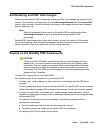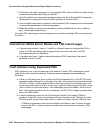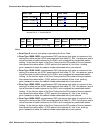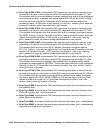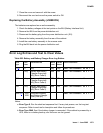
PNC-DUP (PNC Duplication)
Issue 1 June 2005 1865
f. Error Type 10400-10463: a spontaneous PNC interchange took place in response to the
retiring of an alarm on the A-PNC associated with fault class FC_DS1. Use status pnc to
look at the state of health indexes for the PNCs, and investigate any associated alarms.
Adding 1 to the last two digits of the Error Code gives the PN number of the port network
that reported the retired alarm. (10403 points to port network 4.) Use list config
port-network to show the cabinet number associated with a port network.
g. Error Type 10500-10563: a spontaneous PNC interchange took place in response to the
retiring of an alarm on the A-PNC associated with fault class FC_BFD. Use status pnc to
look at the state of health indexes for the PNCs, and investigate any associated alarms.
Adding 1 to the last two digits of the Error Code gives the PN number of the port network
that reported the retired alarm. (10203 points to port network 4.) Use list config
port-network to show the cabinet number associated with a port network.
h. Error Type 10600-10664: a spontaneous PNC interchange took place in response to the
retiring of an alarm on the A-PNC associated with fault class FC_SNIL. Use status pnc to
look at the state of health indexes for the PNCs, and investigate any associated alarms. The
last two digits of the Error Code indicate the fiber-link number of the fiber that reported the
retired alarm. Use list fiber-link to show the location of the fiber.
i. Error Type 10700-10764: a spontaneous PNC interchange took place in response to the
retiring of an alarm on the A-PNC associated with fault class FC_SNIHW. Use status pnc
to look at the state of health indexes for the PNCs, and investigate any associated alarms.
The last two digits of the Error Code indicate the fiber-link number (01-64) of the fiber that
reported the retired alarm. Use list fiber-link to show the location of the fiber.
j. Error Type 11000 – 11063: a spontaneous PNC interchange took place in response to the
occurrence of a major or minor alarm on the A-PNC associated with fault class FC_EAL.
This indicates that one or more Expansion Archangel Links are down. Investigate any
EXP-PN alarms. Adding 1 to the last two digits of the Error Code gives the PN number of
the port network that reported the alarm. (11003 points to port network 4.) Use list
config port-network to show the cabinet number associated with a port network.
k. Error Type 11100 – 11163: a spontaneous PNC interchange took place in response to the
occurrence of a major or minor alarm on the A-PNC associated with fault class FC_INL.
This indicates that one or more neighbor or indirect neighbor links with an EI as an endpoint
have experienced faults. Investigate any alarms against EXP-PN and SN-CONF. Adding 1
to the last two digits of the Error Code gives the PN number of the port network that
reported the alarm. (11103 points to port network 4.) Use list config port-network
to show the cabinet number associated with a port network.
l. Error Type 12000 – 11263: a spontaneous PNC interchange took place in response to the
occurrence of a major or minor alarm on the A-PNC associated with fault class FC_HW.
This indicates that one or more neighbor or indirect neighbor links with an EI as an endpoint
have experienced faults. Investigate any alarms against EXP-PN and SN-CONF. Adding 1
to the last two digits of the Error Code gives the PN number of the port network that
reported the alarm. (11203 points to port network 4.) Use list config port-network
to show the cabinet number associated with a port network.







